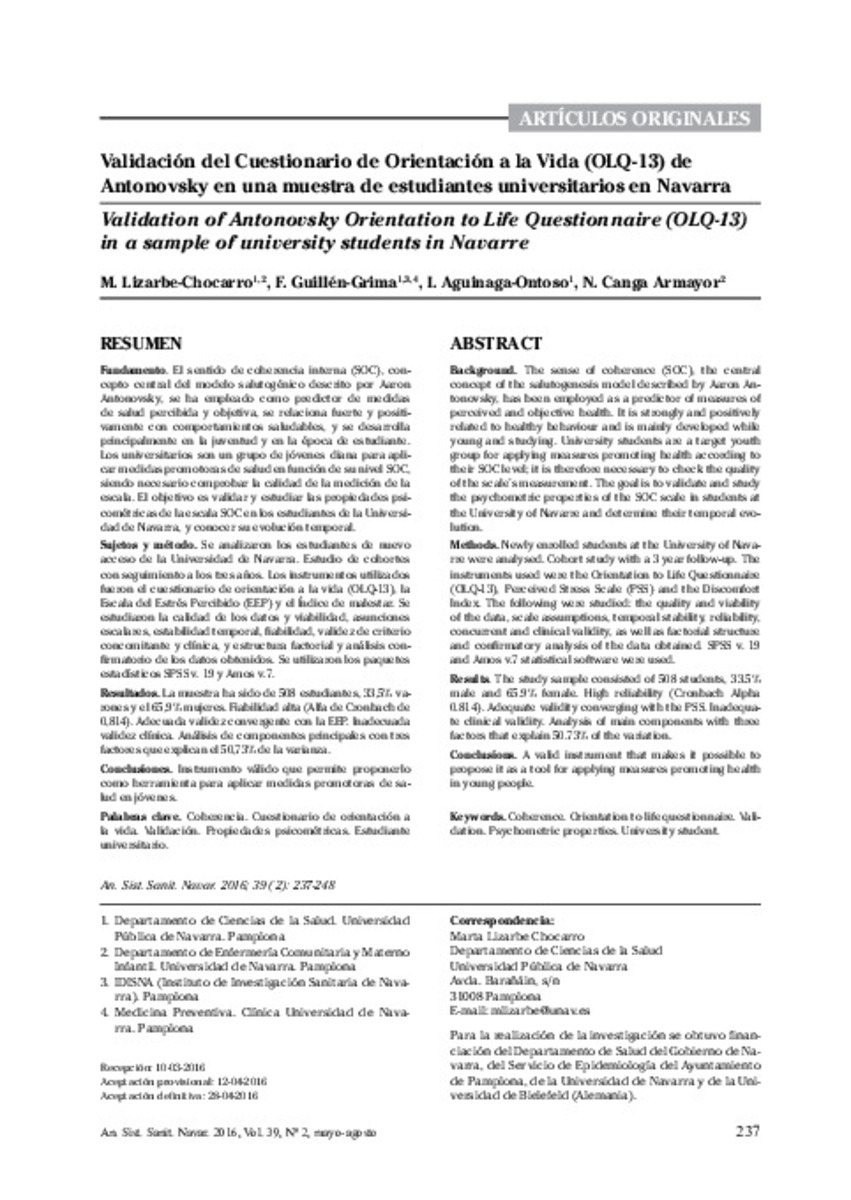Full metadata record
| DC Field | Value | Language |
|---|---|---|
| dc.creator | Lizarbe-Chocarro, M. (Marta) | - |
| dc.creator | Guillen-Grima, F. (Francisco) | - |
| dc.creator | Aguinaga-Ontoso, I. (Inés) | - |
| dc.creator | Canga-Armayor, N. (Navidad) | - |
| dc.date.accessioned | 2023-01-23T12:26:59Z | - |
| dc.date.available | 2023-01-23T12:26:59Z | - |
| dc.date.issued | 2016 | - |
| dc.identifier.citation | Lizarbe-Chocarro, M. (Marta); Guillen-Grima, F. (Francisco); Aguinaga-Ontoso, I. (Inés); et al. "Validación del Cuestionario de Orientación a la Vida (OLQ-13) de Antonovsky en una muestra de estudiantes universitarios en Navarra". Anales del Sistema Sanitario de Navarra. 39 (2), 2016, 237 - 248 | es |
| dc.identifier.issn | 1137-6817 | - |
| dc.identifier.uri | https://hdl.handle.net/10171/65086 | - |
| dc.description.abstract | Fundamento. El sentido de coherencia interna (SOC), concepto central del modelo salutogénico descrito por Aaron Antonovsky, se ha empleado como predictor de medidas de salud percibida y objetiva, se relaciona fuerte y positivamente con comportamientos saludables, y se desarrolla principalmente en la juventud y en la época de estudiante. Los universitarios son un grupo de jóvenes diana para aplicar medidas promotoras de salud en función de su nivel SOC, siendo necesario comprobar la calidad de la medición de la escala. El objetivo es validar y estudiar las propiedades psicométricas de la escala SOC en los estudiantes de la Universidad de Navarra, y conocer su evolución temporal. Sujetos y método. Se analizaron los estudiantes de nuevo acceso de la Universidad de Navarra. Estudio de cohortes con seguimiento a los tres años. Los instrumentos utilizados fueron el cuestionario de orientación a la vida (OLQ-13), la Escala del Estrés Percibido (EEP) y el Índice de malestar. Se estudiaron la calidad de los datos y viabilidad, asunciones escalares, estabilidad temporal, fiabilidad, validez de criterio concomitante y clínica, y estructura factorial y análisis confirmatorio de los datos obtenidos. Se utilizaron los paquetes estadísticos SPSS v. 19 y Amos v.7. Resultados. La muestra ha sido de 508 estudiantes, 33,5% varones y el 65,9% mujeres. Fiabilidad alta (Alfa de Cronbach de 0,814). Adecuada validez convergente con la EEP. Inadecuada validez clínica. Análisis de componentes principales con tres factores que explican el 50,73% de la varianza. Conclusiones. Instrumento válido que permite proponerlo como herramienta para aplicar medidas promotoras de salud en jóvenes. | es_ES |
| dc.description.abstract | Background. The sense of coherence (SOC), the central concept of the salutogenesis model described by Aaron Antonovsky, has been employed as a predictor of measures of perceived and objective health. It is strongly and positively related to healthy behaviour and is mainly developed while young and studying. University students are a target youth group for applying measures promoting health according to their SOC level; it is therefore necessary to check the quality of the scale’s measurement. The goal is to validate and study the psychometric properties of the SOC scale in students at the University of Navarre and determine their temporal evolution. Methods. Newly enrolled students at the University of Navarre were analysed. Cohort study with a 3 year follow-up. The instruments used were the Orientation to Life Questionnaire (OLQ-13), Perceived Stress Scale (PSS) and the Discomfort Index. The following were studied: the quality and viability of the data, scale assumptions, temporal stability, reliability, concurrent and clinical validity, as well as factorial structure and confirmatory analysis of the data obtained. SPSS v. 19 and Amos v.7 statistical software were used. Results. The study sample consisted of 508 students, 33.5% male and 65.9% female. High reliability (Cronbach Alpha 0.814). Adequate validity converging with the PSS. Inadequate clinical validity. Analysis of main components with three factors that explain 50.73% of the variation. Conclusions. A valid instrument that makes it possible to propose it as a tool for applying measures promoting health in young people. | es_ES |
| dc.language.iso | spa | es_ES |
| dc.rights | info:eu-repo/semantics/openAccess | es_ES |
| dc.subject | Coherencia | es_ES |
| dc.subject | Cuestionario de orientación a la vida | es_ES |
| dc.subject | Validación | es_ES |
| dc.subject | Propiedades psicométricas | es_ES |
| dc.subject | Estudiante universitario | es_ES |
| dc.subject | Coherence | es_ES |
| dc.subject | Orientation to life questionnaire | es_ES |
| dc.subject | Validation | es_ES |
| dc.subject | Psychometric properties | es_ES |
| dc.subject | University student | es_ES |
| dc.title | Validación del Cuestionario de Orientación a la Vida (OLQ-13) de Antonovsky en una muestra de estudiantes universitarios en Navarra | es_ES |
| dc.title.alternative | Validation of Antonovsky Orientation to Life Questionnaire (OLQ-13) in a sample of university students in Navarre | es_ES |
| dc.type | info:eu-repo/semantics/article | es_ES |
| dc.publisher.place | Navarra | es_ES |
| dc.description.note | CC BY NC | es_ES |
| dc.identifier.doi | 10.23938/ASSN.0270 | - |
| dadun.citation.endingPage | 248 | es_ES |
| dadun.citation.number | 2 | es_ES |
| dadun.citation.publicationName | Anales del Sistema Sanitario de Navarra | es_ES |
| dadun.citation.startingPage | 237 | es_ES |
| dadun.citation.volume | 39 | es_ES |
| dc.identifier.pmid | 27599951 | - |
Files in This Item:
Statistics and impact
Items in Dadun are protected by copyright, with all rights reserved, unless otherwise indicated.






